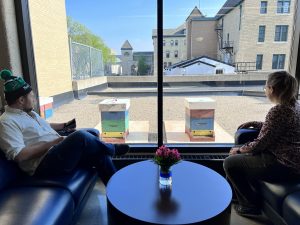BU's Deanna Smid and apiarist Mike Clark examine a frame before moving it into its new hive homes. Source: Brandon University
BRANDON – The Brandon University campus is buzzing again, as honeybee hives have returned for the second year of a pilot project dubbed ‘Bee U’ that demonstrates urban beekeeping in Brandon.
This year’s hives are in a better spot for public viewing and are located on the roof of the Knowles-Douglas Student Union Centre, just outside a bank of plate glass windows that will allow bee-curious people a safe and up-close place to watch the hive activity as well as regular beekeeping duties.
“This is a honey of a location,” quipped Deanna Smid, one of the Bee U project’s coordinators, sitting in one of the comfortable couches that now overlook the hives. “It’s very relaxing to watch the bees go about their work here, it’s got a great view, and it’ll be even better when we add some interpretive signage.”
Last year’s initial foray into urban beekeeping was the first ever trialed in the City of Brandon, requiring a variance from City Council. Partnering with apiarist Mike Clark from the Wawanesa area, BU beekeepers wanted to find out how best to produce honey inside city limits, while also seeing what wider research opportunities might be available.
Results from the first year’s hives were presented to City Council last Monday. With just two hives, installed later in the year than ideal, the project netted 117 kg of honey — a little less than the Manitoba average for professional beekeepers, but a very good result for the first year.
Samples of honey were sent to a lab in Colorado that can do DNA analysis of the pollen that’s trapped inside. They found that that particular sample mostly included pollen that came from plants in the “rose” family, such as spirea.
“Excitingly, another significant percentage of pollen came from cucumber plants,” Smid said. “This means that the honeybees were pollinating vegetables in Brandon — helping increase the bounty of neighbourhood gardens.”
While a key goal of Bee U is to assess urban beekeeping in Brandon and determine what is needed to best support and regulate beekeepers, the project has also helped raise awareness of the plight of pollinators, including honeybees, and has helped support local food security.
Media coverage of last year’s hives reached an estimated audience of 2.2 million people around the world, especially once cameras were installed to let people tune in to the ‘hive-stream’ from anywhere.
While the new location is much better for in-person viewing, Bee U is planning to move the cameras and get the ‘hive-stream’ going again as soon as possible.

Mike Clark and Deanna Smid sit in a publicly accessible seating area that has a safe, close view of the hives. (Photo credit: News.brandonu.ca)
The hives were installed Saturday morning, May 20 (World Bee Day). The initial installation was the same two hives as last year, and as the hives strengthen and grow, they’ll each be split into a total of four hives.
Anyone can help support the Bee U bees (as well as all pollinators) with simple actions at home: planting pollinator-friendly plants and flowers, and delaying intensive yard work like raking or mowing until late spring or early summer, for example.
The public is invited to come view the hives anytime the university is open. The best viewing is from the upper floor of the McMaster Hall entrance, which is located off 18th Street, set behind the BU bus stop.
Project updates will be posted to the Bee U website at BrandonU.ca/Bee-U.
